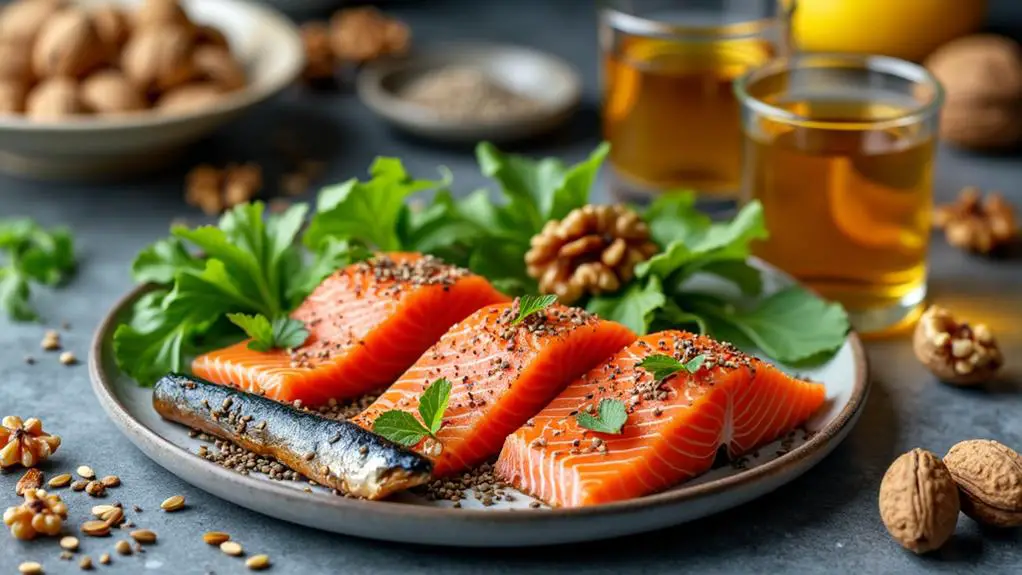The Role of Omega-3s in Family Nutrition: Food Sources to Consider
Omega-3 fatty acids play an essential role in your family's health, supporting brain development, heart health, and reducing inflammation. You'll find these crucial nutrients in fatty fish like salmon, mackerel, and sardines, as well as plant-based sources such as flaxseeds, chia seeds, and walnuts. The American Heart Association recommends eating two servings of fatty fish weekly to get EPA and DHA, while plant sources provide ALA. Tailor intake to age-specific needs, with pregnant women and children requiring special attention. By incorporating a variety of omega-3-rich foods into your family's meals, you'll boost overall health and well-being. Discover how to easily add these powerhouse nutrients to your diet.
Key Takeaways
- Fatty fish like salmon, mackerel, and sardines are excellent sources of EPA and DHA omega-3s.
- Plant-based sources like flaxseeds, chia seeds, and walnuts provide ALA omega-3s for vegetarian options.
- Omega-3s support brain development in children and reduce heart disease risk in adults.
- The American Heart Association recommends two servings of fatty fish weekly for optimal omega-3 intake.
- Pregnant and breastfeeding women have increased omega-3 needs for fetal development and infant health.
Understanding Omega-3 Fatty Acids
Omega-3 fatty acids are essential nutrients your body can't produce on its own. These polyunsaturated fats come in three main types: ALA, EPA, and DHA. While ALA is found in plant-based sources, EPA and DHA are primarily sourced from fatty fish. Your body can convert ALA to EPA and DHA, but this process is inefficient, making it vital to consume EPA and DHA directly from food sources.
Omega-3s offer numerous health benefits, particularly for brain and eye function. The American Heart Association recommends eating at least two servings of fatty fish per week to guarantee adequate intake.
It's important to balance your omega-3 consumption with omega-6 fatty acids, as Western diets often contain excessive omega-6s, which may counteract omega-3's anti-inflammatory benefits.
Health Benefits for Family Members
When it comes to family nutrition, incorporating omega-3 fatty acids can benefit every member of your household. These essential nutrients support brain development in infants and children, enhancing cognitive function and growth.
For adults, omega-3s reduce the risk of heart disease, lowering triglyceride levels and improving overall heart health. Pregnant and breastfeeding women require higher omega-3 intake to guarantee peak fetal development.
These fatty acids may also alleviate symptoms of depression and anxiety, contributing to better mental health for all family members. By including omega-3-rich food sources like salmon, walnuts, and flaxseeds in your family meals, you'll promote joint health and reduce inflammation.
This is especially beneficial for active family members and those with arthritis. Embracing omega-3s in your diet can lead to improved health outcomes for everyone, from the youngest to the oldest in your family.
Fish and Seafood Sources

When considering fish and seafood sources of omega-3s for your family, you'll want to focus on fatty fish like salmon, mackerel, and sardines.
It's important to balance your choices with sustainability concerns and mercury levels, especially for pregnant women and children.
You can opt for lower mercury alternatives like light canned tuna, anchovies, and Pacific chub mackerel while still meeting the recommended two servings of fatty fish per week.
Best Fish for Omega-3s
Five fatty fish stand out as excellent sources of omega-3 fatty acids: salmon, mackerel, sardines, herring, and anchovies. These cold-water fish are rich in EPA and DHA, with a 3-ounce serving of salmon providing up to 952 mg of DHA.
The American Heart Association recommends eating two servings of fatty fish per week to reap the health benefits of omega-3s.
If you're concerned about mercury levels, opt for canned light tuna instead of albacore. Pacific chub mackerel is another safe choice, especially for pregnant women and children.
However, it's best to limit or avoid high-mercury fish like King mackerel, shark, and swordfish. By incorporating these omega-3-rich food sources into your family's diet, you'll be supporting heart health and overall well-being.
Seafood Sustainability Considerations
In light of growing concerns about overfishing and marine ecosystem health, it's crucial to take into account sustainability when choosing omega-3-rich seafood for your family.
Opt for sustainable seafood choices like Alaskan salmon, sardines, and Pacific mackerel, which have lower environmental impacts compared to overfished species.
Look for certifications from the Marine Stewardship Council (MSC) or Aquaculture Stewardship Council (ASC) to identify responsibly sourced products.
Consider farmed fish raised in environmentally responsible conditions as a viable alternative to wild-caught options. They can provide important omega-3s while reducing pressure on wild populations.
Choosing local or regional sources can further support sustainability efforts by lowering transportation-related carbon footprints.
Mercury Concerns and Alternatives
Despite the numerous health benefits of omega-3-rich seafood, concerns about mercury contamination can't be ignored, especially for families with young children or expecting mothers.
To balance omega-3 intake with safety, consider these low mercury options:
- Anchovy, Herring, Salmon, and Sardines
- Light canned tuna (limit to 6 oz/week for pregnant women)
- Fatty fish recommended by the American Heart Association
Pregnant women, children under 11, and other sensitive groups should prioritize these safer choices to minimize health risks while reaping the benefits of omega-3s.
The American Heart Association advises two servings of fatty fish per week, emphasizing lower mercury options.
By selecting these food sources, you'll support your family's health without compromising safety.
Remember to avoid high-mercury fish like King mackerel, Marlin, and Swordfish when planning your meals.
Plant-Based Omega-3 Options
While fish and seafood are often touted as prime sources of omega-3s, plant-based options offer a wealth of these essential fatty acids, particularly in the form of alpha-linolenic acid (ALA).
You'll find ALA in flaxseeds, chia seeds, walnuts, hemp seeds, and canola oil. Flaxseeds are especially rich, providing about 6,403 mg of ALA per tablespoon.
For adults, aim for 1.6 grams (men) or 1.1 grams (women) of ALA daily. These plant-based omega-3 options support heart health and reduce inflammation.
However, your body inefficiently converts ALA to EPA and DHA. If you're vegetarian or vegan, consider algae oil supplements for direct DHA intake.
Dietary Recommendations by Age

Understanding omega-3 dietary needs across age groups is essential for family nutrition. Your family's omega-3 requirements vary with age and life stage.
Infants need 0.5g of ALA daily, while children's needs increase from 0.7g to 0.9g as they grow. Adolescents have higher requirements, with teen boys needing 1.6g and girls 1.1g of ALA per day.
Adults should aim for similar amounts, with men requiring 1.6g and women 1.1g daily.
Pregnant and breastfeeding women need increased ALA intake of 1.4g and 1.3g, respectively.
The American Heart Association recommends adults consume at least two servings of fatty fish weekly for EPA and DHA.
Key points to remember:
- ALA needs increase with age
- Teens and adults have gender-specific requirements
- Pregnancy and breastfeeding demand higher ALA intake
- Fatty fish provides essential EPA and DHA
Incorporating Omega-3s Into Meals
Boost your family's omega-3 intake by making simple changes to your meal planning and preparation. Incorporate fatty fish like salmon or mackerel twice a week to meet the AHA recommendation for heart health.
For plant-based sources, add flaxseeds, chia seeds, or walnuts to smoothies and oatmeal. If you're following a vegan diet, consider algal oil supplements for DHA and EPA.
Don't forget omega-3 fortified foods such as eggs and yogurts to increase overall intake in family diets. When cooking, use oils rich in ALA, like flaxseed or canola, to balance omega-3 and omega-6 fatty acids.
These simple additions can provide a nutritious boost to your meals. By making these adjustments, you'll be supporting your family's health while enjoying delicious and varied meals that incorporate essential omega-3s.
Conclusion
You've now got a thorough understanding of omega-3s and their importance for your family's health. Remember, it's not just about knowing the facts, but putting them into practice. Start small: try swapping out one meal a week with an omega-3-rich option. The Johnson family did this and saw improvements in their children's focus at school within a month. With consistent effort, you'll be nurturing your family's health one meal at a time.







